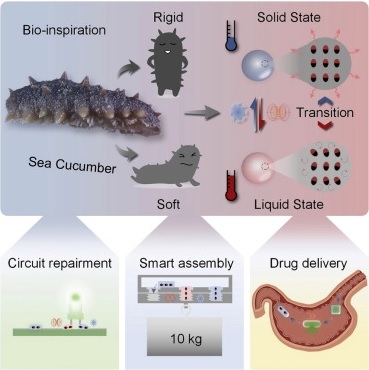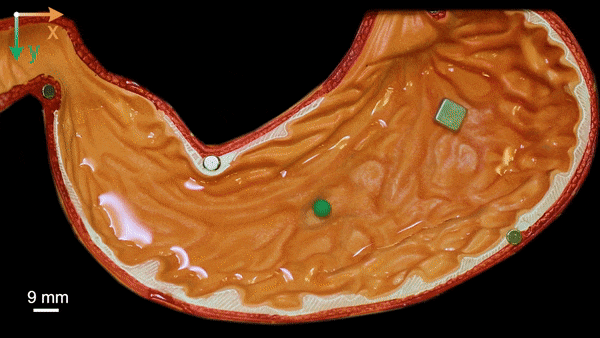Flight. Invisibility. Mind-reading. Super-strength. These powers have mostly been limited to the realms of science fiction and fantasy, though we’re starting to see robots and computers replicate some of them. Now a small robot built by an international team has a new superpower: shape-shifting. Or perhaps a more accurate name would be… state-shifting.
Described in a paper published last week in Matter, the robot can go from a solid state to a liquid state based on manipulation of the magnetic fields around it. The team developed the robot as an attempt to get the best of both worlds in terms of robotic properties and capabilities. Hard robots often can’t access certain spaces because of their inflexible bodies, while flexible robots lack strength and durability. Why not make a bot that can do it all?

Videos show the robot “escaping” from a cage and extracting a ball from a model of a human stomach. The researchers say it could have all kinds of real-world applications, from performing tasks in tight spaces (like soldering a circuit board) to accessing parts of the body that are hard to reach (like the inside of the intestines) to acting as a universal screw by melting and reforming into a screw socket.
The robot is made primarily of gallium, a soft, silvery metal that’s used in electronic circuits, semiconductors, and LEDs. Its most useful feature in this case is its very low melting point: gallium melts at a cool 85.57 degrees Fahrenheit (29.76 degrees Celsius). That’s just slightly above room temperature (in a warm room, admittedly), or the outdoor temperature on a midsummer day.
The team sprinkled magnetic particles throughout the gallium, and these are key to the robot’s functionality.
“The magnetic particles here have two roles,” said the paper’s senior author and mechanical engineer Carmel Majidi of Carnegie Mellon University. “One is that they make the material responsive to an alternating magnetic field, so you can, through induction, heat up the material and cause the phase change. But the magnetic particles also give the robots mobility and the ability to move in response to the magnetic field.”
Gallium’s low melting point meant that exposing it to a rapidly-changing magnetic field generated enough electricity within the metal to cause it to heat up and melt. In the “prison break” experiment the researchers set up, the robot escaped its cell and re-solidified into its original form on the other side. It should be noted that the bot isn’t yet able to re-assume its original form without help, though; there was a mold waiting for it outside the cell.
[embedded content]
Despite not having quite reached Terminator status, the ease with which the robot’s state can be manipulated could give it a major advantage over existing phase-shifting materials, which tend to require heat guns or electrical currents to go from solid to liquid. The gallium-based bot is also more fluid in its liquid form than similar materials.
When they used it in a model of a human stomach to remove an object, the solid robot was able to move quickly to the object, melt down, surround the object, coalesce back into a solid, and move out of the stomach with the object. The team noted that although the robot worked well in the model, pure gallium would quickly melt inside a real human body; they’d have to add metals like bismuth and tin to raise the material’s melting point for use in biomedical applications.

“What we’re showing are just one-off demonstrations, proofs of concept, but much more study will be required to delve into how this could actually be used for drug delivery or for removing foreign objects,” said Majidi.
The team got some of their inspiration for the robot from sea cucumbers, which can quickly change their stiffness back and forth. They call their invention a “magnetoactive solid-liquid phase transitional machine.” Using magnetic fields, the robots were also able to jump over moats, climb walls, and support heavy weight.
The next step is for the team to search for more real-world applications for their technology, and tweak its properties accordingly. Chengfeng Pan, an engineer at the Chinese University of Hong Kong who led the study, said, “Now we’re pushing this material system in more practical ways to solve some very specific medical and engineering problems.”
Image Credit: Q. Wang et al/Matter 2023 (CC BY-SA)
- SEO Powered Content & PR Distribution. Get Amplified Today.
- Platoblockchain. Web3 Metaverse Intelligence. Knowledge Amplified. Access Here.
- Source: https://singularityhub.com/2023/02/01/watch-this-shape-shifting-robot-melt-to-escape-a-cage-then-reform/



